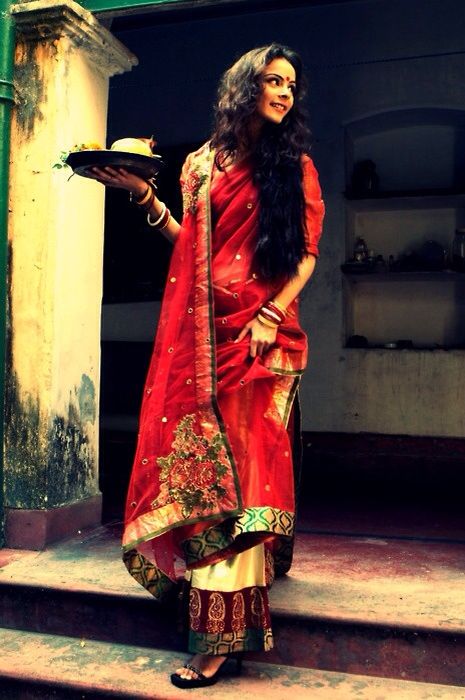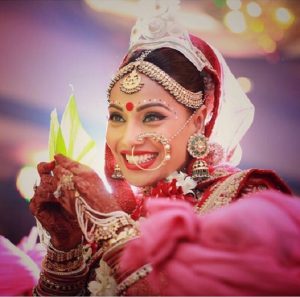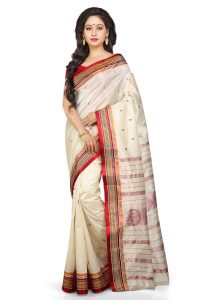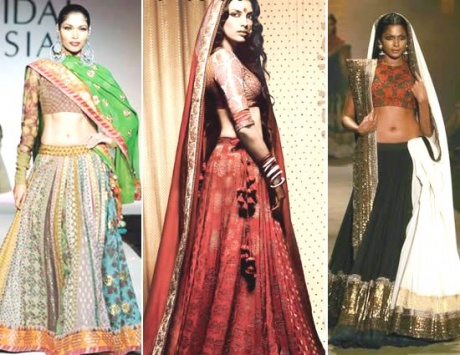
Ethnic Wear From Bengal

Bengali Bride (source: rediff.com)
What’s the first thing that comes in mind when you think about Bengal? Yes, most would think sweets and a delectable palate of cuisines. What’s the second thing? Undoubtedly it is their clothing. The fabrics and attires of the state of Bengal are closely associated with the color white. Take for example, the Bengali saree. The spotless white saree with a border in red embodies the pride of Bengali culture. The drape too can be distinguished from the usual way in which a North Indian or a Gujarati would drape a saree.
Background
The culture of Bengal, like that of innumerable other lands of India, has been influenced by the various civilizations that settled there for a certain period of time. If one goes by the historical texts then the state of Bengal had a close stint with the Mauryan legacy. Moreover, in the seventh century, the states of Bengal and Bihar came under the rule of the kingdom of Magadh.
Being one of the four main kingdoms that existed during the time of Mahavira and Budhha, Bengal till date nurtures the value system of the spiritual times in its value system. Needless to say, the traditional attire of Bengal was a reflection of the influences that it drew and imbibed from the legacy of varied cultural ideologies that it witnessed.
Varieties
At the hub of Bengali clothing are two things:
a) the culture and value-system of Bengal
b) the tradition of weaving.
Clothing for men and women in Bengal can be classified under two main heads mentioned as follows:
Traditional/Occasional Wear: The women of Bengal take pride in the traditional sari. The world renowned Bengali saree has been so well received that it has earned the status of a cult fashion. A particular style of sari that is known as the shari is the trademark of the local attire for the women. The sarees are mostly made of Silk and have a heavily embroidered pallu or border.
What makes Bengali sarees extremely exquisite is the craftsmanship and hard work that goes into manufacturing and designing each one of them. Garad silk sarees, Jamdani, Tant, Sournachuri or Baluchuri Saree are among the popular traditional sarees from Bengal.
Every woman of Bengal owes a rare elegance to the saree weavers who are absolutely adept in their art. The quintessential appeal of each saree is enriched by the thread work in shimmering Gold that embellishes the border. Thankfully, a Bengali saree is extremely comfortable to wear, despite of the fact that it looks quite heavy.
For the men, the traditional fashion wear includes Punjabis and lungis. The former is a loosely fitted garment of knee-length. A Punjabi is quite similar to a kurta; however, is made out of Silk. Meant to be a casual wear, the Punjabis despite of their appeal are not worn on special occasions. Lungis on the other hand are a type of dhoti. Meticulously crafted in Silk, Batik or Cotton fabrics, the lungi is a comfortable garment that comes in a range of colors.
The design trends of traditional Bengali couture are woven in the costumes displaying the art of Kantha. A kind of thread work that requires utmost concentration and technique, Kantha till date is quite in demand.
Modern Day Clothing
Nowadays, Bengalis all over the world believe in sporting clothing from every culture and from all walks of life. Women opt for attires like salwar kameez and cotton sarees. They are seen wearing western clothes as well. The traditional clothing is mosty reserved for special occasions and religious ceremonies.
Occasion Dressing
The appeal of the Bengali couture lies in its originality of style. The traditional way of draping a Bengali saree, for example, is reserved for occasions that are truly special. A ceremony like marriage or Durga Puja is the time when a Bengali woman dresses for the occasion, in the true colors of her culture. She drapes the white and red couture in a manner that the pallu of the saree is left freely hanging from her left shoulder. The drape is uncomplicated in style, yet extremely elegant.
Seasonal Wear
Made of pure Silk, the Bengali sari is comfortable to be worn at times and places that has pleasant weather. Silk fabrics are also comfortable during winters. However, they are not suitable during extreme summers and humid weather.
References
Categories: Attires, Clothing Styles & Drapes


